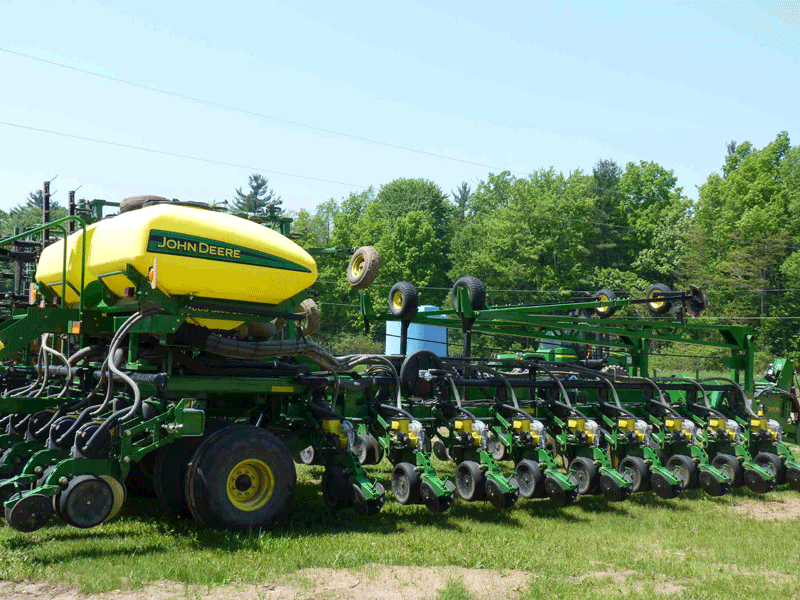Early warnings
RESEARCHERS IDENTIFY POTENTIAL CHALLENGES
ADVANCED TRAIT TECHNOLOGY can present both opportunities and challenges to Ontario farms. As planting options grow in complexity, researchers are focused on working with products before they become available to ensure they can guide growers through managing new cultivars once released. For specialists at the University of Guelph today, this means analyzing 2,4-D and dicamba tolerant soybeans from all angles.

Dr. Peter Sikkema, Field Crop Weed Management Professor at the University of Guelph Ridgetown Campus, is currently leading a three-year project involving Roundup Ready 2 Xtend™ and Enlist E3™ soybeans. His main objective is to quantify the potential injury and loss due to sprayer tank contamination with either 2,4-D or Banvel®.
“I think that there is a real fit for this technology to address problem weeds in Ontario but proper tank clean out procedures are going to be extremely important,” says Sikkema. “To illustrate this point, we are looking at the impact of tank contamination on regular Roundup Ready soybeans.”
IN THE FIELD
Sikkema says the idea for this research came from the notion of a grower renting a new piece of land with significant weed control problems. If the grower decides to plant a 2,4-D or dicamba tolerant cultivar in this field, they will spray it appropriately and may then move on to spraying a neighbouring field.
“We are looking at the scenario where they planted Roundup Ready soybeans without the gene that confers the resistance in the neighbouring field,” he says. “We are determining what the impact is at various levels of contamination.”
Sikkema and his team have completed two years of this project, assuming a range of tank contamination rates and applying 2,4-D and Banvel® at the two to three trifoliate leaf stage and at the early flowering stage.
INITIAL IMPACT OF 2,4-D
According to Sikkema’s data, Roundup Ready® soybeans that are treated with a tank containing 2,4-D at a one percent contamination rate show seven percent visible crop injury one week after application. This figure was consistent over both application times.
When the contamination was applied at the two to three trifoliate stage, injury was recorded at five percent, three percent, and zero after two, four, and eight weeks respectively.
When application occurred at first flower, seven percent injury was observed two weeks after and two percent injury occurred at both the four and eight week marks.
Sikkema’s results thus far indicate that there is no decrease in plant stand with a tank containing 2,4-D at a one percent contamination, but that there is up to a five percent decrease in plant height. The data shows no yield loss when sprayed at the two to three trifoliate stage and a five percent loss when applied at first flower.
DIACAMBA TRIALS
Three grams per hectare of Banvel® herbicide equates to a tank contamination rate of one percent. “We are finding that this level of tank contamination significantly impacts Roundup Ready soybeans and serves as a caution to growers to complete proper tank clean out procedures,” says Sikkema.
One week after application, 28 and 16 percent visible crop injury was shown when tank contamination occurred at the two to three trifoliate stage and first flowering stage respectively. When measured at the two week mark, these figures increased to 49 and 27 percent.
Four weeks after application, 41 and 39 percent injury was recorded when sprayed at the two stages as listed above. At eight weeks after application, injury declined but remained significant at 22 and 41 percent.
Sikkema says there was no decrease in plant stand which means that the plants were stunted but not killed. The Roundup Ready® soybeans did experience a decrease in height between 22 and 25 percent.
When application occurred at the two to three trifoliate stage, the soybeans showed a yield loss of 14 percent. When sprayed at first flower, this loss increased to 22 percent.
NEXT STEPS
Sikkema plans to continue one additional year of trials in 2014 and once complete, will be analyzing the full three years of data. The results of the trials and his final conclusions will then be published.
“If there are high value, sensitive crops in adjacent fields, it may be recommended that growers choose not to use 2,4-D and dicamba tolerant technology because of the potential of crop injury due to physical or vapour drift,” says Sikkema.
“When it comes to 2,4-D and dicamba tolerant soybeans, there is a positive message for Ontario growers because I think they will get increased yield through improved weed control of glyphosate-resistant Canada fleabane, giant ragweed and common ragweed,” he says.
“But I will be warning farmers, and I cannot stress enough, how important tank clean out procedures will be to avoid serious impacts in other fields.”
Research funding for this project is provided by Monsanto Canada. •






















